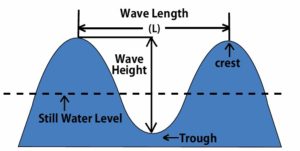What Causes Waves?
Waves around Hawaii shorelines are caused by storms thousands of miles away – at least the waves that surfers want. Local storm-driven surf is usually too windy and choppy. Far away storms such as hurricanes, cyclones and polar lows create winds that result in waves that travel very long distances. Three factors of the wind hitting the ocean water during these storms affect the swell – fetch, velocity and duration. When winds (velocity) blow for a period of time (duration), over an area (fetch), a ripple affect is started. This ripple affect is similar to throwing a rock into water.

The ripple is a transfer of energy that when unobstructed can travel thousands of miles. When the water’s energy hits shallow rock or coral, a sandbar or a river mouth, the energy is transformed into a breaking wave. When the ocean energy encounters a shallow land mass and local conditions, the wave shows its true form. Local conditions include winds, tide, currents, storms, ocean floor topography and shoreline configuration. Local high winds will ruin most good swells. And local storms usually result in a lot of land run-off dirtying the water.
Wave Sizes

Wave heights are generally measured two ways, face scale and Hawaiian scale. In scientific terms and most used by the surfing community around the world, the wave height is measured vertically from the trough to the crest and is known by surfers as face scale. In Hawaii, local surfers use the back of the wave to measure wave height and is called Hawaiian scale or local scale. The history of Hawaiian scale and the conversion itself are widely discussed and debated. The conversion from face to Hawaiian is roughly 1/2 to 2/3 the size measured from trough to crest.

There are many factors that distort this conversion and social distortion and perception are probably the biggest. For example, some surfers tend to brag up the size of the wave like exaggerating fishermen. Some hardcore surfers purposefully understate size. The reason for this is uncertain as some say it’s a reverse cool factor of making big wave surfing seem easy. Many people have no idea what size the waves are and they just throw a numberout there. Other factors that affect the conversion of face and local wave sizes are the size of the swell, which surf break is being measured, the methods of measurement, local winds, currents and tides.

A simple solution used by many surfers to communicate wave height is to relate the wave size to the human body. Flat, knee high, waist high, shoulder high, head high, overhead, double overhead, triple overhead are used rather than numeric sizes. But you still can’t please everyone, some will argue it depends on the height of the surfer.
Sets
Waves come in sets of waves. Between sets there are lulls when there are no breaking waves. If there is a swell, then the sets will be larger and more steady. On days with no swell and small waves, decent sets could be 10 minutes apart or more. A single set can bring as little as one or two good waves, whereas a good set can bring more than 10 surfable waves. If it is a good set, wait for a few waves to pass and other surfers to go, and time your wave as necessary.
Wave Anatomy

surfer in a barrelling wave on Hawaii’s north shore